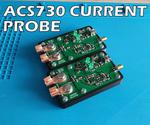Other

“If you’ve ever worked with some sort of power electronics or high current devices before, you may have also asked yourself how the current waveform looked in those devices, specially if you were troubleshooting them. Well, since this is …

The ACS730 current sensor family provides a 1 MHz bandwidth with lightning fast 210 ns response time sensing for AC or DC current sensing in automotive, industrial, commercial, and communications systems. The device is designed for high-frequency switching applications and can be used to replace high-frequency current transformers. The ACS730 can reduce overall BOM cost and PCB area, while increasing quality in customer applications, making it superior to larger, bulky current transformers. Typical applications include power supplies, DC/DC converters, and chargers for industrial and automotive markets. The package provides a 2400 VRMS 60 second isolation rating and can be used on voltage rails as high as 420 V AC, RMS or DC. The device consists of a precise, low-offset, linear Hall sensor circuit with a copper conduction path located near the surface of the die. Applied current flowing through this copper conduction path generates a magnetic field which is sensed by the integrated Hall IC and converted into a proportional voltage. Device accuracy is optimized through the close proximity of the magnetic field to the Hall transducer. A precise, proportional voltage is provided by the Hall IC, which is programmed for accuracy after packaging. The output of the device has a positive slope when an increasing current flows through the primary copper conduction path (from pins 1 and 2, to pins 3 and 4), which is the path used for current sensing. The internal resistance of this conductive path is typically 1.2 mΩ, providing low power loss. The terminals of the conductive path are electrically isolated from the sensor leads (pins 5 through 8). This allows the ACS730 current sensor to be used in high-side current sense applications without the use of high-side differential amplifiers or other costly isolation techniques. The ACS730 is provided in a small, low-profile surface-mount SOIC8 package. The leadframe is plated with 100% matte tin, which is compatible with standard lead (Pb) free printed circuit board assembly processes. Internally, the device is Pb-free, except for flip-chip high-temperature Pb-based solder balls, currently exempt from RoHS. The device is fully calibrated prior to shipment from the factory.

“If you’ve ever worked with some sort of power electronics or high current devices before, you may have also asked yourself how the current waveform looked in those devices, specially if you were troubleshooting them. Well, since this is …